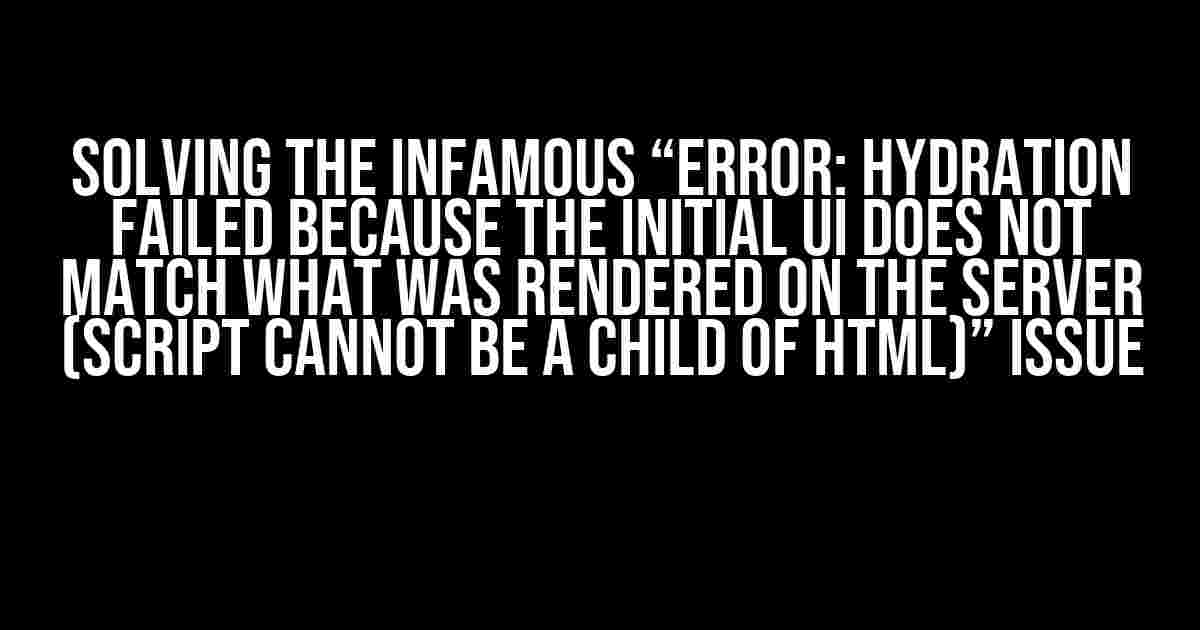If you’re reading this, chances are you’ve encountered one of the most frustrating errors in the React world: “Error: Hydration failed because the initial UI does not match what was rendered on the server (script cannot be a child of html)”. Don’t worry, we’ve got you covered! In this article, we’ll dive deep into the reasons behind this error, and more importantly, provide you with actionable steps to resolve it once and for all.
What’s Causing the Error?
Before we jump into the solutions, let’s understand what’s causing this error in the first place. The “Hydration failed” error occurs when the server-side rendering (SSR) of your React application doesn’t match the client-side rendering. But why does this happen?
- Wrong component hierarchy: When the React component tree on the server-side differs from the client-side, React gets confused and throws this error.
- Invalid HTML structure: If the HTML sent from the server is malformed or doesn’t match the client-side rendering, React will fail to hydrate the application.
- Script tags in the wrong place: Yep, you guessed it – when script tags are placed directly inside the HTML tag, React freaks out!
Script Tags: The Usual Suspects
Script tags are often the culprits behind this error. Why? Because React expects script tags to be wrapped inside a container element, like a div or a span. When a script tag is placed directly inside the html tag, React gets confused about where to render the application.
<html> <script>...</script> <body>...</body> </html>
Avoid placing script tags directly inside the html tag at all costs! Instead, wrap them inside a container element, like so:
<html>
<body>
<div>
<script>...</script>
</div>
</body>
</html>
Solutions to the “Hydration failed” Error
Now that we’ve identified the common causes, let’s get to the solutions! Follow these steps to resolve the “Error: Hydration failed because the initial UI does not match what was rendered on the server (script cannot be a child of html)” issue:
- Verify your component hierarchy: Double-check that your component tree is correctly structured on both the server-side and client-side. Make sure to use the same components and props on both sides.
- Inspect your HTML structure: Use the browser’s developer tools to inspect the HTML sent from the server. Ensure that it’s properly formatted and matches the client-side rendering.
- Move script tags to a container element: Wrap script tags inside a container element, like a
divor aspan, as shown earlier. - Check for duplicate IDs: If you’re using a library like React Helmet, ensure that you’re not generating duplicate IDs for elements. This can cause React to fail hydration.
- Verify your server-side rendering setup: Make sure your server-side rendering setup is correct. Check that you’re using the correct renderer and that your server-side code is properly configured.
- Try a different render method: If you’re using a library like Next.js, try switching to a different render method, such as
getStaticPropsorgetServerSideProps.
| Solution | Explanation |
|---|---|
| Verify component hierarchy | Ensure that your component tree is correctly structured on both server-side and client-side. |
| Inspect HTML structure | Use the browser’s developer tools to inspect the HTML sent from the server and ensure it’s properly formatted. |
| Move script tags to a container element | Wrap script tags inside a container element, like a div or a span, to avoid React errors. |
| Check for duplicate IDs | Ensure that you’re not generating duplicate IDs for elements, which can cause React to fail hydration. |
| Verify server-side rendering setup | Make sure your server-side rendering setup is correct and that you’re using the correct renderer. |
| Try a different render method | Switch to a different render method, such as getStaticProps or getServerSideProps, to resolve the issue. |
Conclusion
The “Error: Hydration failed because the initial UI does not match what was rendered on the server (script cannot be a child of html)” issue can be frustrating, but with these solutions, you should be able to resolve it. Remember to:
- Verify your component hierarchy
- Inspect your HTML structure
- Move script tags to a container element
- Check for duplicate IDs
- Verify your server-side rendering setup
- Try a different render method
By following these steps, you’ll be able to identify and fix the root cause of the error, and your React application will be up and running in no time!
Frequently Asked Questions
Got stuck with the annoying “Error: Hydration failed” issue? Don’t worry, we’ve got you covered!
What does the “Hydration failed” error even mean?
This error occurs when the initial UI sent by the server doesn’t match what the client-side React app renders. It’s like trying to put a square peg into a round hole – just not gonna work! It usually happens when there’s a mismatch between the server-side and client-side rendering of your React app.
Why does this error occur when I add a script tag to my HTML file?
Ah-ha! That’s because a script tag can’t be a direct child of the HTML element. You need to wrap it in a body or head tag. Think of it like trying to put a toy car in a box without a lid – it just won’t fit!
How do I fix the “Hydration failed” error in my React app?
Easy peasy! Just make sure your server-side and client-side rendering match. Check that your HTML structure is the same on both sides, and that you’re not adding any extra elements or attributes on the client-side. It’s like doing a puzzle – you need to make sure all the pieces fit together perfectly!
Can I just ignore this error and move on?
Uh-oh, nope! Ignoring this error can lead to all sorts of issues, like broken functionality, inconsistent rendering, or even security vulnerabilities. It’s like putting a Band-Aid on a broken leg – it won’t fix the underlying problem, and you’ll end up with more trouble down the road!
Are there any tools that can help me debug this error?
You bet! The React DevTools can help you inspect the component tree and identify where the mismatch is happening. You can also use the browser’s DevTools to inspect the HTML and see what’s going on. It’s like having a superpower to see what’s going on behind the scenes!


